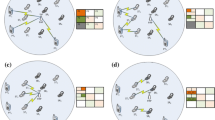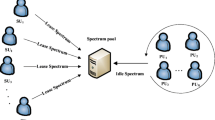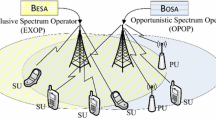Abstract
Cognitive radio is known to be an important technology to overcome the shortage of spectrum resources, and the resource allocation problem of multi-service multi-carrier slice in 5G system has remained a challenge. In this paper, a multi-leader multi-follower Stackelberg game is designed to analyze the interaction between operators and users over licensed and unlicensed bands. Further, we verify the impact of users’ dynamic throughput allocation ratio on Nash equilibrium (NE) in the game. The game is divided into two independent subgames: licensed band and unlicensed band games. A simplified Vickrey-Clarke-Groves algorithm is designed in the former sub-game to ensure the fairness of user transmission. In the latter, an interference price is set to protect the transmission performance of primary users in unlicensed band. By predicting the actions of other players, optimal prices or spectrum and power demands are set in a non-cooperative way. We prove the existence of NE solution in the Stackelberg game and design dynamic distributed algorithms for operators and users to achieve NE. Simulation results show the effectiveness of our proposed resource management schemes based on Stackelberg game. Compared to other Stackelberg models, our scheme provides users with high-quality services and provides a guidance on pricing strategies for operators.









Similar content being viewed by others
References
Shahid, A., Maglogiannis, V., Ahmed, I., et al. (2019). Energy-efficient resource allocation for ultra-dense licensed and unlicensed dual-access small cell networks[J]. IEEE Transactions on Mobile Computing, 20(99), 1–1.
Zhou, Z., Chen, X., & Gu, B. (2019). Multi-scale dynamic allocation of licensed and unlicensed spectrum in software-defined hetnets[J]. IEEE Network, 33(4), 9–15.
Hanawal, M. K., Hayel, Y., & Zhu, Q. (2020). Effective utilization of licensed and unlicensed spectrum in large scale ad hoc networks[J]. IEEE Transactions on Cognitive Communications and Networking, 6(2), 618–630.
Kim, S. (2020). Two-level game based spectrum allocation scheme for multi-flow carrier aggregation technique[J]. IEEE Access, PP(99), 1–1.
Zhu, F., An, L., & Lau, V. K. N. (2017). Joint interference mitigation and data recovery for massive carrier aggregation via non-linear compressive sensing[J]. IEEE Transactions on Wireless Communications, PP(99), 1–1.
Lin, S., Kong, L., Gao, Q., et al. (2018). Abstract advanced dynamic channel access strategy in spectrum sharing 5g systems dynamic spectrum management for 5g[J]. IEEE Wireless Communications. https://doi.org/10.1109/MWC.2017.1700091.
Vamvakas, P., Tsiropoulou, E.E., & Papavassiliou, S. (2019). Dynamic spectrum management in 5G wireless networks: A real-life modeling approach[C]// IEEE INFOCOM 2019 - IEEE Conference on Computer Communications, IEEE.
Ali, M., Qaisar, S., Naeem, M., et al. (2020). LTE-U WiFi hetnets: Enabling spectrum sharing for 5G/beyond 5G systems[J]. IEEE Internet of Things Magazine. https://doi.org/10.1109/IOTM.0001.2000024.
Hassan, M., Singh, M., & Hamid, K. (2021). Survey on advanced spectrum sharing using cognitive radio technique[M].
Loginov, V., Lyakhov, A., & Zhdanovskiy, V. (2019). Performance analysis of lbt with limited reservation signal duration for fair lte-laa/wi-fi coexistence, In 2019 IEEE International Black Sea Conference on Communications and Networking (BlackSeaCom).
Chen, L., Liu, C., Hong, X., Wang, C. X., Thompson, J., & Shi, J. (2016). Capacity and delay tradeoff of secondary cellular networks with spectrum aggregation. IEEE Transactions on Wireless Communications, PP(99), 1–1.
Li, Y., Zhang, W., Wang, C. X., Sun, J., & Liu, Y. (2020). Deep reinforcement learning for dynamic spectrum sensing and aggregation in multi-channel wireless networks. IEEE Transactions on Cognitive Communications and Networking, 6(2), 464–475.
Chang, B.J., & Chang, W. T. (2019). Cost-reward-based carrier aggregation with differentiating network slicing for optimizing radio rb allocation in 5g new radio network , In 2019 IEEE 10th Annual Information Technology, Electronics and Mobile Communication Conference (IEMCON).
Zheng, J., Xiao, J., Ren, Q., & Zhang, Y. (2020). Performance modeling of an lte laa and wifi coexistence system using the laa category-4 lbt procedure and 802.11e edca mechanism. IEEE Transactions on Vehicular Technology, PP(99), 1–1.
Zou, J., Huang, L., Gao, X., & Xiong, H. (2018). Joint pricing and decision-making for heterogeneous user demand in cognitive radio networks. IEEE Transactions on Cybernetics, PP(99), 1–14.
Zhang, H., Du, J., Cheng, J., & Leung, V. (2017). Resource allocation in swipt enabled heterogeneous cloud small cell networks with incomplete csi, In In 2016 IEEE Global Communications Conference (GLOBECOM).
Bu, S., Yu, F. R., & Yanikomeroglu, H. (2015). Interference-aware energy efficient resource allocation for ofdma-based heterogeneous networks with incomplete channel state information. IEEE Transactions on Vehicular Technology, 64(3), 1036–1050.
Zhang, H., Yong, X., Cai, L. X., et al. (2017). A multi-leader multi-follower stackelberg game for resource management in LTE unlicensed[J]. IEEE Transactions on Wireless Communications, 16(1), 348–361.
Ning, B., Sun, G., Li, J., Zhang, A., & Yang, S. (2020). Resource allocation in multi-user cognitive radio network with stackelberg game. IEEE Access, PP(99), 1–1.
Zhang, H., Di, B., Bian, K., & Song, L. (2019). Iot-u: Cellular internet-of-things networks over unlicensed spectrum. IEEE Transactions on Wireless Communications, 18(5), 1–1.
Zhang, W., Wang, C. X., Ge, X., & Chen, Y. (2018). Enhanced 5g cognitive radio networks based on spectrum sharing and spectrum aggregation. IEEE Transactions on Communications, PP(12), 1–1.
Zhou, J., Zhang, Y., Cao, Z., & Dong, X. (2019). Ppsas: Lightweight privacy-preserving spectrum aggregation and auction in cognitive radio networks, In 2019 IEEE 39th International Conference on Distributed Computing Systems (ICDCS).
Michelusi, N., Nokleby, M., Mitra, U., & Calderbank, R. (2019). Multi-scale spectrum sensing in dense multi-cell cognitive networks. IEEE Transactions on Communications, 67(4), 2673–2688.
Yi, H., Liu, Y., Fan, P., Fang, S., & Ma, Y. (2017) An adaptive access control mechanism for laa and wi-fi coexistence in unlicensed band, In 2017 3rd IEEE International Conference on Computer and Communications (ICCC).
Xiao, Y., Hirzallah, M., & Krunz, M. (2018). Distributed resource allocation for network slicing over licensed and unlicensed bands. IEEE Journal on Selected Areas in Communications. https://doi.org/10.1109/JSAC.2018.2869964.
Bairagi, A.K., Tran, N. H. & Hong, C. S. (2018). A multi-game approach for effective co-existence in unlicensed spectrum between lte-u system and wi-fi access point, In International Conference on Information Networking.
Li, C., Li, J., Li, Y., et al. (2019). Pricing game with complete or incomplete information about spectrum inventories for mobile virtual network operators[J]. IEEE Transactions on Vehicular Technology, 68(11), 11118–11131.
Hafaiedh, H., Korbi, I. E., Langar, R., Saidane, L. A., & Kobbane, A. (2019). Canonical coalition game for solving wifi and lte coexistence issues on the 5ghz band, In 2019 15th International Wireless Communications and Mobile Computing Conference (IWCMC).
Abass, A., Kumbhkar, R., Mandayam, N. B., & Gajic, Z. (2018). Wifi/lte-u coexistence: An evolutionary game approach. IEEE Transactions on Cognitive Communications and Networking. https://doi.org/10.1109/TCCN.2018.2886011.
Shahid, A., Maglogiannis, V., Ahmed, I., et al. (2019). Energy-efficient resource allocation for ultra-dense licensed and unlicensed dual-access small cell networks[J]. IEEE Transactions on Mobile Computing, PP(99), 1–1.
Wang, X., Li, Z., Xu, P., Xu, Y., & Chen, H. H. (2010). Spectrum sharing in cognitive radio networks-an auction-based approach. Systems, Man, and Cybernetics, Part B: Cybernetics, IEEE Transactions on, 40(3), 587–596.
Glicksberg, I. L. (1952). A further generalization of the Kakutani fixed point theorem, with application to nash equilibrium points[J]. Proceedings of the American Mathematical Society, 3(1), 170–174.
Fudenberg, D., Tirole, J. (1991). Game theory[M]. MIT press.
Lassonde, M., & Schenkel, C. (1992). KKM principle, fixed points, and nash equilibria[J]. Journal of Mathematical Analysis and Applications, 164(2), 542–548.
Tang, Q., Xie, R., Huang, T., et al. (2019). Jointly caching and computation resource allocation for mobile edge networks[J]. IET Networks, 8(5), 329–338.
Niyato, D., & Hossain, E. (2008). Competitive spectrum sharing in cognitive radio networks: A dynamic game approach. IEEE Transactions on Wireless Communications, 7(7), 2651–2660.
Ma, Tengteng, Zhang, Yong, Wang, Fanggang, Wang, Dong, & Guo, Da. (2020). Slicing resource allocation for embb and urllc in 5g ran. Wireless Communications and Mobile Computing. https://doi.org/10.1155/2020/6290375.
Mohammadian, H.S., Abolhassani, B. (2010). A new price-based spectrum sharing algorithm in cognitive radio networks[C]// International Conference on Software. IEEE.
Acknowledgements
The authors would like to thank the reviewers for their detailed reviews and constructive comments, which have helped improve the quality of this paper. This work is supported by the National Natural Science Foundation of China under Grant No. 61971057.
Author information
Authors and Affiliations
Corresponding authors
Additional information
Publisher's Note
Springer Nature remains neutral with regard to jurisdictional claims in published maps and institutional affiliations.
Appendices
Appendix A: The Proof of Theorem 1
Proof
The pure policy set of users is concave, closed and bounded. The second partial derivative is as follows:
where \({a_{ - j}} = \mathop \sum \limits _{z \in {N_{i,l}}} a_{i,z}^{\left( l \right) } - a_{i,j}^{\left( l \right) }\). The function is always less than zero in the domain of definition, which satisfies the definition of concave function. There is the second order partial derivative:
The function is always greater than zero in the domain of definition, which satisfies the definition of convex function. Theorem 1 shows that there is at least one pure strategy Nash equilibrium in sub-game 1.
From \(\frac{{\partial {U_{j,a}}}}{{\partial {a_j}}} = 0\), we get \(a_{i,j}^{\left( l \right) *} = \sqrt{\frac{{{\gamma _j}{R_{i,j}}{a_{ - j}}}}{{\rho _i^{\left( l \right) }}}} - {a_{ - j}}\). Substitute \(a_{i,j}^{\left( l \right) *}\) into the function of Leader1,
There is the second order partial derivative:
The function is always less than zero in the domain of definition, which satisfies the definition of concave function. From \(\frac{{\partial {W_{i,a}}}}{{\partial \rho _i^{\left( l \right) }}}\), we get \(\rho _i^{\left( l \right) *} = \frac{{{{(\mathop \sum \nolimits _{j \in {N_{i,l}}} \sqrt{{\gamma _j}{R_{i,j}}{a_{ - j}}} )}^2}}}{{4{{\left( {{N_{i,l}} - 1} \right) }^2}{{\left( {{a_j} + {a_{ - j}}} \right) }^2}}}\).
Lemma 1 shows the basic conditions for the existence of Nash equilibrium. We have proved that sub-game 1 satisfies the conditions of Lemma 1and obtained a unique set of equilibrium solutions. A set of Nash equilibrium solutions is obtained as:
\(\square\)
Appendix B: The Proof of Theorem 2
Proof
The pure policy set of users is concave, closed and bounded. The second partial derivative is as follows:
The function is always greater than zero in the domain of definition, which satisfies the definition of convex function. From \(\frac{{\partial {U_{j,b}}}}{{\partial {p_j}}} = 0\), we get \(p_j^\mathrm{{*}} = \frac{{{\gamma _j}B_u^{\left( l \right) }}}{{{g_j}\mathop \sum \nolimits _{k = 1}^M r_k^{\left( l \right) }}} - \frac{{{z_j} + {p_{ - j}}{g_{ - j}}}}{{{g_j}}}\). Substitute \(p_j^\mathrm{{*}}\) into the function of Leader2:
There is the second order partial derivative:
where \(r_{ - i}^{\left( l \right) } = \mathop \sum \limits _{k = 1}^M r_k^{\left( l \right) } - r_i^{\left( l \right) }\). The function is always less than zero in the domain of definition, which satisfies the definition of concave function. From \(\frac{{\partial {W_{i,b}}}}{{\partial r_i^{\left( l \right) }}} = 0\), we get \(r_i^{\left( l \right) *} = \sqrt{\frac{{r_{ - i}^{\left( l \right) }\mathop \sum \nolimits _{k = 1}^M \;\mathop \sum \nolimits _{j \in {N_{k,l}}} {\gamma _j}B_u^{\left( l \right) }}}{{\mathop \sum \nolimits _{k = 1}^M \;\mathop \sum \nolimits _{j \in {N_{k,l}}} \left( {{z_j} + {p_{ - j}}{g_{ - j}}} \right) }}} - r_{ - i}^{\left( l \right) }\).
Lemma 1 shows the basic conditions for the existence of Nash equilibrium. We have proved that sub-game 2 satisfies the conditions of Lemma 1 and obtained a unique set of equilibrium solutions. A set of Nash equilibrium solutions is obtained as:
where \({\left( x \right) ^ - } = \mathrm{{min}}\left\{ {x,p^{max}} \right\}\). \(\square\)
Rights and permissions
Springer Nature or its licensor holds exclusive rights to this article under a publishing agreement with the author(s) or other rightsholder(s); author self-archiving of the accepted manuscript version of this article is solely governed by the terms of such publishing agreement and applicable law.
About this article
Cite this article
Chai, Y., Zhang, Y., Ma, T. et al. Research on multi-service slice resource allocation over licensed and unlicensed bands. Wireless Netw 29, 1–17 (2023). https://doi.org/10.1007/s11276-022-03088-5
Accepted:
Published:
Issue Date:
DOI: https://doi.org/10.1007/s11276-022-03088-5




